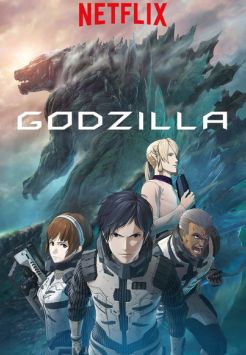
Giant monsters rose up all over Earth, with the final one being Godzilla, and destroyed human civilization. Two alien races arrived at the last minute to help—the highly religious Exif and the engineering-obsessed Bilusaludo—but they failed. A single spaceship escaped, with a mixed crew, looking for a new world. Twenty years later, with things looking bleak on the ship, the overly emotional and disgraced Haruo throws a tantrum, and follows that up with a plan to defeat Godzilla. As the crew can’t find a new planet, they decide to return to Earth, where 20,000 years will have passed. After arriving, they find Earth has changed wildly, and worse, Godzilla is still alive. A team, including Haruo and other humans, along with a few of each of the aliens, lands with the intension of killing Godzilla. One plan leads to the next, which leads to the next as the continuously unpleasant Haruo and company attempt to survive and destroy Godzilla. While the human’s plans are overly clear, that’s not the case for the Houtua (naturalistic descendants of humanity that live in caves and worship an egg), who have a different way of looking at things, nor for either the the Exif or the Bilusaludo, both of whom have secrets.
This is a rough one. The story, once you put it all together, is excellent. The theme is strong, the viewpoint interesting, and I suspect it will stick with me for some time. But man, is it a slog to get there. You pay for every worthwhile moment and concept with annoyance and boredom and stupidity. I can’t tell if this is brilliance as told by a clod or idiocy sculpted by a genius, though the first seems more likely. I prefer films to give without taking. This one makes you earn it.
So let’s start with the basics. The Trilogy is Japanese anime, made with uneven animation (it’s better with monsters and explosions than with people). The three parts are Godzilla: Planet of the Monsters, Godzilla: City on the Edge of Battle, and Godzilla: The Planet Eater, and none of those are standalone films. This is one film, and that’s the way to watch it, in a 4½ hour block. Each piece is made to match the others structurally, with an hour (or more) of excessive talking before finally getting to a single blow-out fight. This makes for a plodding viewing experience.
So why all the talking? Well, Toho wanted more females to watch Godzilla films, and they figured that girls don’t like monsters fighting. Instead, girl like lots of emotional talking. They also like deep themes and character development, but mainly emo-ladened exposition. I can’t say I think much of Toho’s R&D department. So, the idea was to make a 3-part Godzilla film with as little Godzilla in it as possible, instead using space opera as the background, but also limiting the science fiction action in favor of demonstrative chatting.
So a majority of the movie(s) is unpleasant or uninteresting humans (and near-humans) talking, or more often, yelling. Most of the characters are both stupid and angry, ranting for little reason. During one monster-action scene, we keep cutting back to a band of humans, who, for ten minutes, between describing exactly what we can see, yell:
What the hell are they?!
That’s impossible!
They’re all unresponsive!
Impossible!
What?
A malfunction?!
It isn’t working here!
What?!
It’s not working!
There’s no response!
What’s going on?!
No, it can’t be!
Are you saying it’s a hallucination?!
It makes no sense!
It’s a contradiction!
Then what’s happening?!
What’s going on?!
Still nothing is showing up on the sensors!
It still shows nothing!
Etc.
It gets very tiring.
And no one is angrier and yells more than Haruo. I imagine Haruo getting up each morning and stabbing his eggs while he screams at them that they don’t understand. Unless you love toddlers kicking and screaming, he is the definition of non-entertaining.
Occasionally the characters do calm down enough to spit out exposition. There’s nothing they like to do more, beyond yelling that other people’s ideas are insane, than describing their plans, and then new plans, and then altered plans. Carrying out those plans? That only fills a few minutes. It’s talking about the plans that takes up time.
Which makes it a miracle that I’m giving this even a slight recommendation. But the story is interesting, eventually. There are rich ideas here that could have made a spectacular film, if an hour of talking had been cut. The world, with Mechagodzilla city and strange life forms is a great foundation. The politics of the ship is tense and compelling (at least in theory). And the Bilusaludo’s plans and Houtua’s actions are all solid material for a movie. But what really elevates it is the cult subplot. Everything dealing with religion works, particularly statements about humanity’s willingness to embrace and celebrate lies. Once the focus becomes worship, the slow pace even stops being a problem (and Haruo shuts up for minutes at a time, which really helps). It even makes some of the boring sections intriguing, and one character easier to deal with, retroactively.
The Godzilla Anime Trilogy is a movie where it is preferable to already have seen it, then to be watching it. But that means it is worth watching, with the right mindset. If you are a Godzilla fan in search of monster mayhem, you’ll be disappointed (unless you’ve gotten used to little Godzilla in your Godzilla movies). And if you don’t like Godzilla canon mangled, you’re going to be miserable.
I tried both the English dub and in Japanese with subtitles. The Japanese is better, but not significantly so, and I suspect if you are going to watch this, it will be the dubbed version on Netflix.